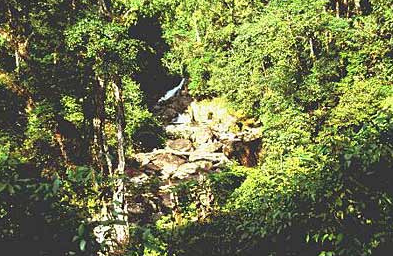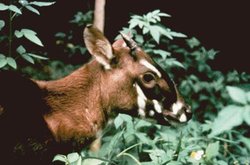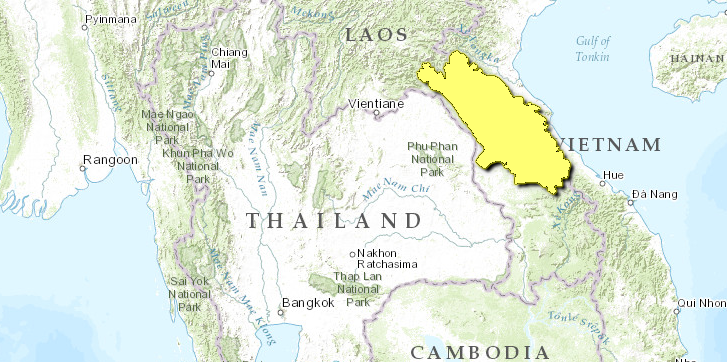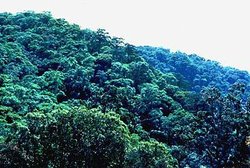Northern Annamites rain forests
Introduction The discovery of a new vertebrate species usually is a newsworthy achievement. But to discover five large or midsized mammals, including two that belong to new, monotypic genera within the space of five years, is truly astounding. It also epitomizes the globally outstanding biological diversity (Northern Annamites rain forests) of the Northern Annamites Rain Forests. It was just under a decade ago that the Saola (Pseudoryx nghetinhensis) was discovered during biological surveys of the intact forests along the rugged and little-explored mountains of the northern Annamite Range. Soon thereafter the giant muntjac (Megamuntiacus vuquangensis) was discovered in the same area. Since then there has been a spate of discoveries and rediscoveries of species that have not been seen for years since their first description.
Location and General Description
The Northern Annamites Rain Forests ecoregion lies largely in Laos but with a significant area across the crest of the Annamite Range in Vietnam. Geological substrates are varied over this ecoregion, but there are notable large areas of limestone karst topography. Climatic conditions often change abruptly along the mountain crest. Lower moisture input from the northeast monsoon winds produces mean annual rainfall in montane habitats of this ecoregion in Laos that are lower at 1,500-2,500 millimeters (mm) and more seasonal than those of the Northern Vietnam Lowland Rain Forests. However, higher elevations produce cooler temperatures and thus distinct conditions for plant growth. This ecoregion shows strong floristic relationships with the mountains of northern Vietnam and southern China and with more southern areas of the Annamite Range. Vascular plant levels of endemism are high.
Mesic lower montane forests at 800-1,200 meters (m) in the northern Annamite Range generally consist of a two-tiered forest canopy reaching to about 15-25 m in height. The dominant floristic elements in this forest are the Myrtaceae, Fagaceae, Elaeocarpaceae, and Lauraceae, with high endemism. Also notable in this forest community is the presence of species of Podocarpaceae. Epiphytes, particularly orchids, are abundant and rich in endemic species. The dense canopy structure of undisturbed humid montane forest allows little light to penetrate to ground level, so understory vegetation is sparse. However, the understory in open areas of forest often supports thick stands of woody bamboo (Chimonobambusa and Dendrocalamus). It has been suggested that typhoons that regularly reach this area provide a natural disturbance regime that continually opens the canopy and promotes bamboo growth.
Less mesic sites with thin, acid soils at elevations up to 1,500 m often support pine forests with Pinus kesiya as the dominant species. Under reasonable growing conditions, P. kesiya reaches 20-30 m in height. The most common tree associates of P. kesiya are Keteleeria evelyniana, Pieris ovalifolia, Schima wallichii, and Tristania merguensis. Frequent fire seems to promote the establishment and maintenance of these pine forests at the expense of hardwoods. A second community of open conifer forest in montane areas of northern Laos is dominated by Keteleeria evelyniana, which may occur in pure stands or mixed with Pinus kesiya and species of Fagaceae. Keteleeria may reach up to 35 m in height and occurs from subtropical areas of southern China southward into Laos and Vietnam.
Humid montane forests at about 1,200-1,800 m may support a rich forest dominated by Fokienia hodginsii, Podocarpus imbricatus, and Cunninghamia lanceolata. Fokienia can reach 40-50 m in height and 1.5 m in diameter in this community. The cool and moist conditions of these Fokienia forests often promote lush growth of cryptogamic epiphytes and an accumulation of organic litter on the forest floor.
Long histories of human impact in the northern Annamite Range of Laos and Vietnam have led to the degradation of large areas of what were once montane evergreen forest. Such forests have been replaced by thickets or savannas with diverse structure depending on the degree of degradation and the time for successional recovery since major disturbance. Thickets may include diverse assemblages of woody species or be dominated by pure stands of a single colonizing species.
Further floristic and faunal surveys are needed to assess the biological potential of this ecoregion, especially in Laos. However, the Vietnamese portion of this ecoregion contains high species diversity and is notable for its significant endemism.
Biodiversity Features
|
Table 1. Endemic and Near-Endemic Mammal Species. Family Species Cercopithecidae Semnopithecus francoisi Hylobatidae Hylobates gabriellae Bovidae* Pseudoryx nghetinhensis* Cervidae* Megamuntiacus vuquangensis* Cervidae* Muntiacus truongsonensis* Cervidae* Muntiacus (Buhouang muntjak)* Cercopithecidae Pygathrix nemaeus An asterisk signifies that the species' range is limited to this ecoregion This treasure trove of biological diversity (Northern Annamites rain forests) is still divulging its true riches. Each new survey turns up new species of mammals, birds, fishes, herptiles, butterflies, and plants. Of the 134 mammals now known from the ecoregion, three are near-endemic species and four are endemic (Table 1). More than half of these are recently described species; therefore, it is very likely that several species could be added to this list as surveys continue. The mammal assemblage also includes several threatened species, including the endangered Douc langur, tiger (Panthera tigris), Asian elephant (Elephas maximus), gaur (Bos gaurus), banteng (Bos javanicus), serow (Capricornis sumatraensis), and particoloured flying squirrel (Hylopetes alboniger). The ecoregion overlaps with a Level I Tiger Conservation Units (TCU) and two Level II TCUs, but the prey base necessary to maintain tigers is declining rapidly because of hunting pressure. Most of the habitat in the ecoregion is too steep for elephants, which are limited to the lower elevations. But as these more accessible midmontane forests are cleared for agriculture, elephants are becoming pocketed in small forest patches. The bird fauna in the ecoregion is estimated at more than 525 species, including 3 near-endemic and 3 endemic species (Table 2). The imperial pheasant (Lophura imperialis) and Edwards's pheasant (L. edwardsi) are critically endangered, and the Vietnamese fireback (L. haitensis) and white-winged duck (Cairina scutulata) are endangered species found in this ecoregion. Not surprisingly, the ecoregion overlaps with an EBA, Annamese Lowlands (143), which contains nine restricted-range bird species. Current Status
| ||||||||



